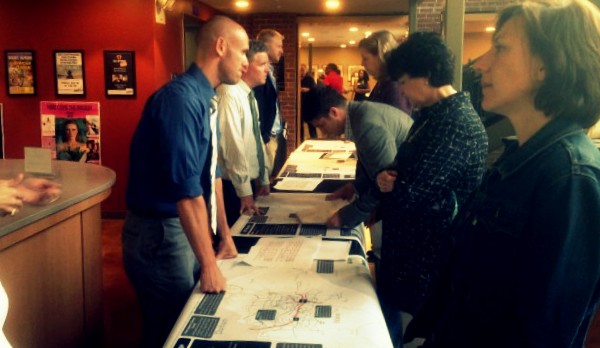Choose Your Transit: 4 Plans for Wake County
Cary, NC — On Tuesday evening, May 19, 2015, Cary residents had their first opportunity to view four different mass transit plans put together by The Wake County Transit Strategy group.
Cary’s Choose Your Transit Meeting
The meeting allowed attendees to provide input and to ask questions to planners from the strategy group that includes members of Go Triangle, Capital Area Metropolitan Planning Organization (CAMPO), The City of Raleigh, The Town of Cary, Research Triangle Foundation of NC, NC State University and the Raleigh-Durham Airport Authority.
A 76-member Transit Advisory Committee (TAC) that represents all the Wake County municipalities was created to develop the broad vision that shaped each of the plans. This meeting was one of several being held this month to gather much needed public feedback before the plans move forward with a possible 1/2 cent sales tax referendum.
Light Rail Off the Table
When initial discussions took place about mass transit in the Triangle, Light Rail had been a big buzzword. That is now off the table in favor of two other ideas that will use existing corridors and cost less. Those ideas are Bus Rapid Transit (BRT) and Rail Rapid Transit (RRT).
The Four Plans
The four plans have different aims in an effort to balance the diverse needs of the entire Triangle region. Two plans are Rapid Rail-based and two plans are Rapid Bus-based.
In each of these categories, there are two models–one focused on covering the most area so that all Wake residents have access (coverage), and one focused on serving high-density areas where more people will utilize transit (ridership).
Attendees to this meeting were presented with four large maps to review and discuss. Then, we rated the top three priorities that we felt must be addressed in the future of transit planning.
All of the plans focus heavily on the major East-West corridor between Downtown Raleigh – Downtown Cary and RTP. The coverage plans include towns on the perimeter with less frequent service (possibly as long as once per hour), while the Ridership plans focus mainly on that corridor using Downtown Raleigh and Downtown Cary as hubs for additional spur routes.
Ridership vs. Coverage
The ultimate plan will need to balance ridership with coverage. The plan must strike a balance of getting riders (a profitable model) but must also be fair to smaller out-lying towns that are helping to pay for these projects and have needs too (an equitable model). In the future, these outlying towns will see their car commute times double. If we put plans in place for them now, they will have options. It will also allow car-less employees to work in downtown areas.
Other issues will involve implementation. The rapid bus ridership (RBT) calls for use of dedicated bus lanes where possible to eliminate traffic hassles, yet many of the road in the plans have no room for widening (think Downtown Cary’s Chatham Street and Morrisville’s Chapel Hill Road).
Timeline
This month, there will be other public meetings throughout the Triangle. Plan feedback will be complete in August 2015 at which time bill 148 has authorized the three governing bodies to move forward with a 1/2 cent sales tax to help pay for everything. Additional funds will be available through vehicle registrations to the tune of $70 million a year.
The timeline is a 10-year plan for complete implementation with some parts of the future plan being ready as soon as funds are available to increase existing bus routes. Higher infrastructure needs (right of way acquisitions and road widening or additional rail lines) would take longer to begin, but, with the goal, could be complete within a twelve year window.
Provide Input Now
To give your input, attend Cary’s next Choose Your Transit meeting:
Choose Your Transit Meeting
Tuesday, May 26, 2015; 10 am-11:30 am
Cary Senior Center, 120 Maury O’ Dell Place, Cary
If you would like to provide input but cannot make a meeting, visit waketransit.com to learn more about the four options and to take a transit survey.
———————————————————————————————————————————
Story and photos by Lindsey Chester.




Elizabeth, good thoughts. A couple of comments. 1)CTran and all other bus services offer 1/2 fare to seniors and disabled riders already. This would continue under any expansion.
2) Cary (and other cities) have been dramatically increasing the amount of greenways and bike lanes, and there are plans for many more. Cary & Morrisville are jointly working on a new greenway that will connect into the Black Creek Greenway and on into Raleigh through Umstead.
3) Go Triangle (Triangle Transit) already has a route that goes directly to RTP from Cary, and in August will be adding service to Perimeter Park. See the service changes for the 300 & 301 at http://www.triangletransit.org/aug2015. All options under consideration for “choose your transit” include a shuttle connection from Morrisville directly to RDU.
I hope you have taken the time to share your comments with the waketransit.com website so that they can be included in the final recommendations.
As population increases widening of roads will always be a temporary solution and encourages more cars on roads. How about smaller buses on more main roads, until ridership increases.
Reduced or free fares for disabled residents.
Complete the greenways plan sooner to provide a safer alternative for bicycle riders, and real, separate, bicycle lanes on roads, not just a painted stamp in a lane than can only accommodate the width of a car.
Yes to lite rail or rapid transit, but please increase, not decrease, frequency and number of routes to the bus and train depots. Cary riders should not have to go to the Raleigh depot in order to get to RTP, the airport, etc.
Thank you!
Someone from C-Tran’s staff can correct me if I’m wrong, but I believe the meeting at the Cary Senior Center is a ‘workshop’ format, not a straight through 1-1/2hr presentation.
So people shouldn’t feel they have to be there exactly at 10am. If they come at 10:30am or 11:00am they’ll still be able to participate.
For those that ride the bus, the C-Tran Outbound #4 bus leaves the Train Depot on the hour, and arrives at the Senior Center approximately 13 minutes after. The Inbound #4 bus leaves the Senior Center at 42 after the our, and arrives at the Train Depot just before the hour.